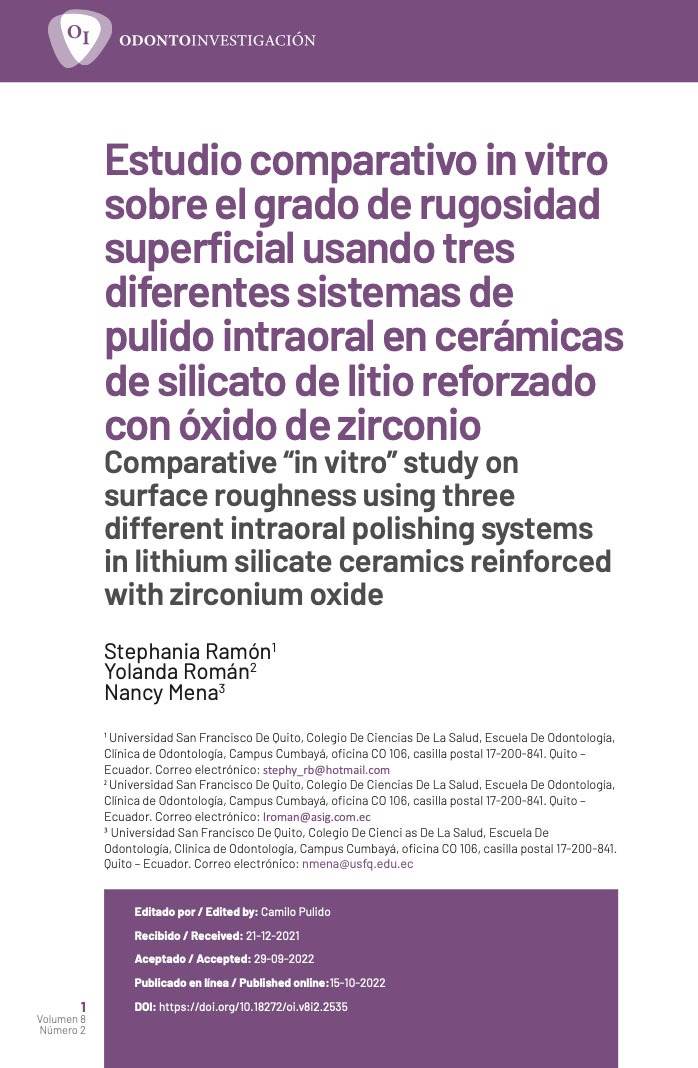Estudio comparativo in vitro sobre el grado de rugosidad superficial usando tres diferentes sistemas de pulido intraoral en cerámicas de silicato de litio reforzado con óxido de zirconio
Main Article Content
Abstract
The aim of this study was to evaluate the surface roughness of zirconia-reinforced lithium silicate ceramics treated with three different intraoral polishing systems from the manufacturers Garrison, Ultradent and Jota. The specimens were Celtra Duo ceramics (Dentsply Sirona) modeled by CAD/CAM in a CEREC unit, and then glazed. The glazed specimens were worn out with a diamond bur to simulate an occlusal adjustment in dental restorations and then treated with the different intraoral polishing systems. Polishing procedures were performed at two intervals of 40s each. Data was statistically analyzed using Student T-tests. All three systems managed to significantly reduce the roughness of the milled surface at the end of the first polishing interval, with significant differences between the three systems. In addition, it was observed that, at the end of the second interval, two systems achieved similar surface roughness, but smoother than the third system. None of the systems managed to recover the original roughness of the glazed ceramic surface. Finally, significant differences from one interval to the next suggest that surface roughness can be further reduced by extending polishing time; however, the increase in polishing time can influence the service life of intraoral instruments and working time. Consequently, the time needed to achieve optimal smoothness in each system should be considered as a key performance aspect in future research on intraoral polishing systems.
Article Details
References
2. Amaya-Pajares S, Ritter A, Vera C, Henson B, Culp L, Donovan T. Effect of Finishing and Polishing on the Surface Roughness of Four Ceramic Materials after Occlusal Adjustment. Journal of Esthetic and Restorative Dentistry. 2016; 28(6): 382-396.
3. Pradíes G, Godoy-Ruiz L, Ozcan M. Analysis of Surface Roughness, Fracture Toughness, and Weibull Characteristics of Different Framework"”Veneer Dental Ceramic Assemblies after Grinding, Polishing, and Glazing. Journal of Prosthodontics. 2017; 00: 1-6.
4. Da Silva T, Rodrigues A, Salvia D., Furtado R, Pagani C, Maranha D, Galera E. Polishing for glass ceramics: Which protocol? Journal of Prosthdontic Research. 2014; 228: 1-11.
5. Carrabba M, Vichi A, Vultaggio G, Pallari S, Paravina R, Ferrari M. Effect of Finishing and Polishing on the Surface Roughness and Gloss of Feldspathic Ceramic for Chairside CAD/CAM Systems. Operative Dentistry. 2016; 41-6: 000-000.
6. Vieira A, Oliveira M, Lima E, Rambob I, Leite M. Evaluation of the Surface Roughness in Dental Ceramics Submitted to Different Finishing and Polishing Methods. J Indian Prosthodont Soc. 2013; 13(3): 290-295.
7. Ho, T., Satterthwaite, J., & Silikas, N. The effect of chewing simulation on surface roughness of resin composite when opposed by zirconia ceramic and lithium disilicate ceramic. Dent Mater. 2017.
8. Mohammadibassir M, R. M. Effect of Two Polishing Systems on Surface Roughness, Topography, and Flexural Strength of a Monolithic Lithium Disilicate Ceramic. Journal of Prosthodontics. 2017; 00: 1-9.
9. Vichi A, Fabian Fonzar R, Goracci C, Carrabba M, Ferrari M. Effect of Finishing and Polishing on Roughness and Gloss of Lithium Disilicate and Lithium Silicate Zirconia Reinforced Glass Ceramic for CAD/CAM Systems. Operative Dentistry. 2018; 43-1: 90-100.


